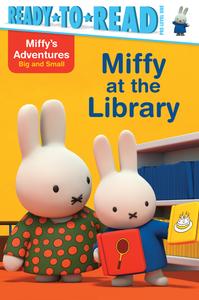Valerie Garfield is a vice-president and the publisher of novelty & licensed publishing in the children's books division of Simon & Schuster. There she oversees the Little Simon and Simon Spotlight imprints, which focus on media tie-ins; the Ready-to-Read beginning reader line; and preschool publishing. She has held positions at HarperCollins, Golden Books and Sesame Workshop, where she was director of publishing before arriving at Simon & Schuster. She also writes for the Simon & Schuster blog as BookMom, helping parents encourage reading.

|
|
| Valerie Garfield | |
How did you land in your position at Simon & Schuster as champion of beginning readers?
I actually started my career as an editorial assistant working on the I Can Read line at HarperCollins. I was lucky enough to help with some wonderful books there, and later at Golden Books when I was on a team launching the Road to Reading line. When I was in licensed publishing at Sesame Workshop, and then again at Simon & Schuster, beginning readers were always a format I helped develop, so I've pretty consistently worked on them for the past 20 years. There's a certain discipline in editing beginning readers, and I think that template has really shaped how I edit books. It's a spare form, and you really have to think about each word.
I have both a soft spot and a fondness for these books because it's magic seeing a child read for the first time. That's the spark that lights a lifetime of reading, and helping create the books that lay the foundation for that is incredibly rewarding.
Do you remember when you first learned to read?
I was an early reader. (Shocker.) My mother, who was a first-grade teacher, taught me how to read using her old Dick and Jane books. The first thing I actually read was a STOP sign. We were in the car and my mother got so excited she almost rear-ended the car in front of us. And honestly that's what I remember most--how excited she was about me reading even if it was just one word. That kind of enthusiasm is contagious for a child.
Tell us more about why the Ready-to-Read team decided not to put age designations on your books.
First of all, you could argue some of those age ranges--like ages 3 to 7--are a little crazy; there is a phenomenal difference between a 3-year-old and a 7-year-old in terms of reading levels and expectations. But mostly we were keenly aware that we didn't want to turn off any kids who may not be reading at level. I've done a lot of tutoring and working in schools with kids who struggle. There is nothing worse than seeing children flip over a book they want to read and see "ages 4 to 8" when they are 8 or even older. They feel deflated and defeated.
Who determines which books are appropriate for which levels? Do you supply guidelines to your authors? Do you have a fleet of educators involved in the process?
We have a fairly strict process in terms of how we assign levels. It's not just "Hey, Bob, this came in and I think it's a level 2. Do you think so? Okay, good, let's make it a level 2." Nope. Each level is determined by word constraints, page counts, dialogue, subject matter and a number of other factors. Authors are guided to write to the level. And after the manuscript is written, and then again after the manuscript is illustrated, outside educational experts are vetting each book to make sure it conforms to those levels.
The levels are also what we call "scaffolded." That means each level builds on the other. So if you have very simple vocabulary in a level 1, you might then move to more complex sentence structure in a level 2. In a level 3 you'll have more dialogue and a complex narrative. The levels are set so that as the child moves through them they are using the skills they've learned on one level and applying it to the next.
How do illustrations correlate with the reading levels? Do type sizes, line spacing and margins figure in as well?
Illustrations are paramount for beginning readers because that's where they are looking for clues if they are stuck on a word or lost in the story. So the illustrations in beginning readers tend to be literal and portray the exact action on each page. We are fortunate to have a very skilled design team working on Ready-to-Reads, and they take great pains to make sure that the text and art are working together. Everything, from the font size to the line spacing and line breaks is taken into account when we're creating a reader, and different levels have different parameters for each of those.

The Ready-to-Read catalogue is full of series starring licensed characters--Peanuts, Batman, Miffy, Kung Fu Panda, the Smurfs.... Tell us what your philosophy is there.
Why not hand readers books that feature their favorite friends? We want to publish books that new readers love. I am fully aware that some take issue with licensed characters in books, but it drives me insane. I've actually had other editors say, "Oh, I don't let my children read those kinds of books." Then they start talking about the latest episode of The Real Housewives. Now I don't want to knock the Housewives, but if there's room in your diet to consume literary classics and popular culture I am unsure why you wouldn't be okay with that for your kids as well.
Are the Ready-to-Reads designed for children to read independently or do you recommend them as read-alouds as well?
I think there's something to be said for parents reading beginning reader books with their children. Often parents see this format as an independent reader, therefore thinking the child should read it independently. To me that's kind of like saying, "Okay, you're old enough to drive, here are the keys." Of course you're going to be in the car with the child, talking him or her through things and possibly even grabbing the wheel a few times. (Or screaming, but I don't recommend screaming when your kids read. Or actually when they drive, either.)
I don't see anything wrong with sitting next to children who are starting to read independently and either helping or prompting them when they get stuck. You are also there to offer encouragement. At first, reading is hard work. Acknowledging that fact--and a little praise--go a long way in encouraging a child to keep going.
How long do children generally stick with the early reader format?
Some kids are in and out of beginner readers in a flash, moving on to more difficult chapter books. Some kids are in beginning readers for quite a while until they master them or gain confidence... or both. The last thing I think beginning readers need is pressure, or to feel badly about how they are reading (or not reading.) And that's really the essence of our line; if you're doing it, you're doing great.

